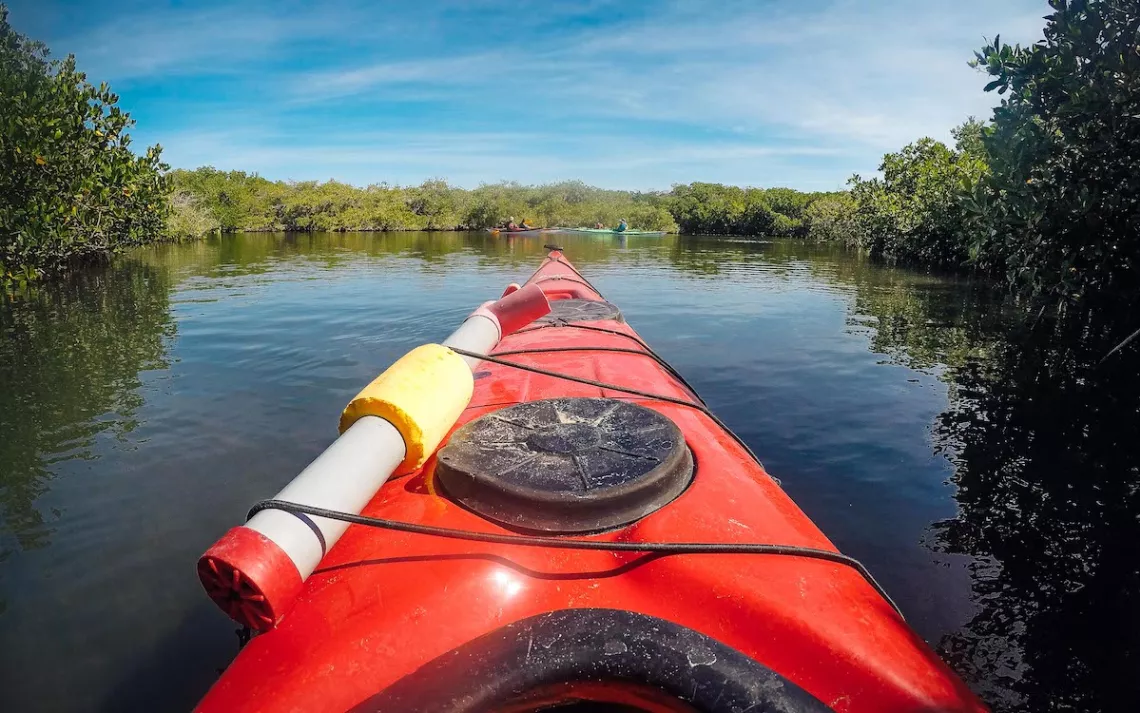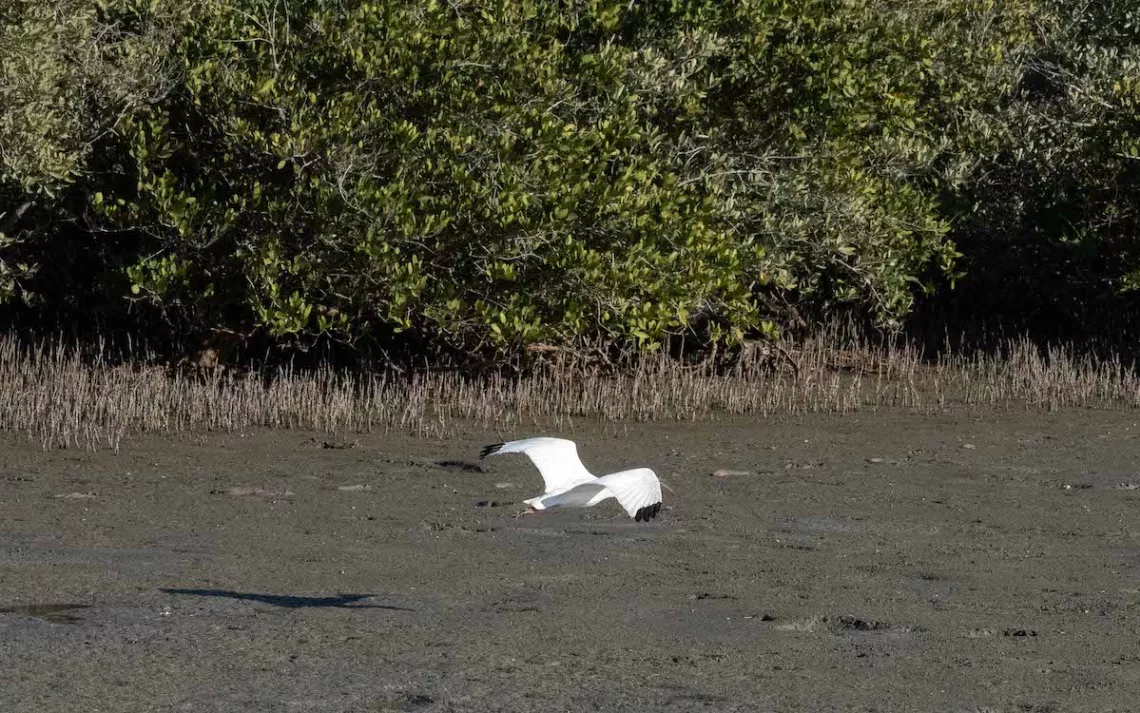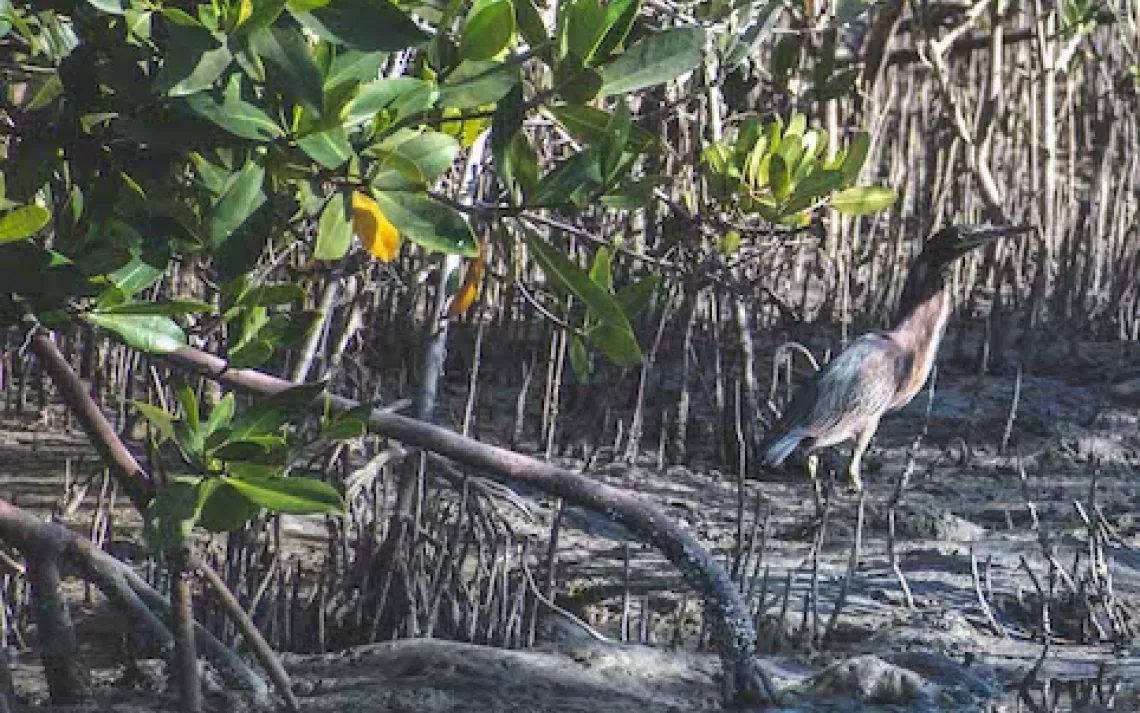The Mystic Mangroves of La Paz
Mangroves naturally fight climate change, but disregard spoils their efforts

A mangrove waterway. | Photos courtesy of Keegan Setner
When conquistadors first floated into the bay of La Paz in the later part of the 16th century, they noticed the tranquility of the water compared with the harsh seas of the South Pacific. The serene inlet was rich with oysters and marlin, while the desert that sloped around its shores was drenched in heat. The native inhabitants of this sharp landscape were the Indigenous Guaycura people. The barbarous conquistadors attacked them and renamed the places they invaded. After a decade of violence, pillaging the natives and their way of life, Admiral Sebastián Vizcaíno named this bay La Paz, meaning peace in Spanish.
Five hundred years after the Spanish conquest, I kayaked through the same waters that were once home to a rich bounty of oysters, which have now been extinct for almost a century. I was here with the nonprofits Blue Turtle Sustainable and Reconciliamar to search for sea turtles in the mangrove forests.
Our small crew set off from the south side of the inlet heading toward the mangrove forest. The collection of trees on the other side of the bay looked like a fortress from far away, but the closer we got, the less intimidating it became. The first thing I noticed were the root systems that protruded into the water like giant spider legs reaching into the wet sand. When the tide is low, mangroves' root systems are fully exposed, giving them a naked and clumsy appearance. When the tide returns, they go back to looking like bushes growing directly out of the sea, except for some extra-spindly roots that remain thrusted out of the water. These are called pneumatophores, and they are mangroves’ special adaptation for breathing during the high tide.
Mangrove roots are sanctuaries—their gnarled and twisted systems allow for fish, turtles, shrimp, snapper, and multiple types of crab to have their own space within the larger context of the ecosystem. Beneath the sand, ecosystem engineers such as worms, clams, amphipods, and sea cucumbers use bioturbation to help stir up the sediment. This oxygenates the soil and gives it a high nutritional density, attracting the creatures that live above the soil.

We paddled against the wind to reach the north side of the inlet, our kayaks gliding along the perimeter of the forest. We were scouting for an entrance that led into the maze of narrow canals and for the unmistakable bob of a turtle's head as it surfaced for a breath of air. We turned a corner and found an entrance, steering the nose of our kayaks into the labyrinth. Once we entered the passageway, the volume of the world seemed to dissolve, and calmness rolled through me. The branches of the mangroves trapped the sound of the crashing waves and raucous seabirds. This was truly a sanctuary.
Our guide, Steve Dresselhaus, directed us to pluck a single leaf off one of the trees and lick it. Salt fastened to my tongue and clung to the roof of my mouth. These small but hardy green leaves excrete salt, which makes them the only type of tree that can live in saltwater. He described how the root systems act as a filter, cleaning the dirty water and returning it to the sea, fresh and clean. As the leaves fall and collect in the soil with the other detritus, they become trapped, forming a carbon sink.

Carbon sinks are natural storage facilities. By sucking up the carbon dioxide from the air and storing it in their roots and branches, they can hold more than 10 times the amount found in forests. Scientists call this “blue carbon,” the storage captured specifically by coastal ecosystems. The main participants in our blue carbon storage systems are mangroves, seagrasses, salt marshes, and peat bogs. Rainforests, or “green carbon,” store directly in the trees, releasing it when the trees pass away. When mangrove root systems go untouched, they have the capacity to store for millennia. They act as a vault for our carbon skeletons.
Marine ecosystems are a natural technology that has the capability of drastically cutting our carbon emissions. Fifty percent of all carbon storage is in ocean sediments. Mangrove deforestation is increasingly common because of port construction, aquaculture facilities, and cattle raising. When mangrove forests are destroyed, the sediment is upheaved, which opens the carbon storage. Since the 1950s, almost half the world's mangroves have been lost to deforestation, releasing a titanic amount of carbon.
The paradox is that while these trees work diligently to draw down the carbon emissions linked to climate change, a hotter planet will undermine their ability to do so. Rising sea levels threaten to expand the time they spend underwater, causing irreparable damage. Decrease in rainfall and higher temperatures threaten their livelihood. Earth’s ecosystems have an inherent design to heal and restore, but they can’t carry the overwhelming burden that humans have pressed upon them.
The fossil fuel industry would like us to believe that it is taking action on climate through programs such as carbon credits: Companies will buy into different types of carbon reserves to offset their emissions. In reality, this is just another case of greenwashing. The French gas company Total, for example, aims to drill in the Republic of the Congo. To offset the drilling, Total planted a forest of fast-growing nonnative trees. The site projected for oil extraction sits atop one of the largest tropical peat deposits, which would crack open a massive natural carbon storage. It would not only release carbon but also threaten a habitat that has yet to be explored by ecologists. The land is also owned unofficially by Indigenous tribes, and the oil company has not contacted them for consent.
The mangrove forest that sits on the perimeter of the quiet Baja California city of La Paz is safe for now, but with more people moving in, it is becoming more vulnerable. While visiting La Paz, tourists will most likely find themselves swimming with whale sharks, sandboarding down colossal dunes, or kayaking through mangroves. Much of the tourism in La Paz is integrated to support the environment, as opposed to exploiting it. Despite this culture of responsible ecotourism, increased population growth, as well as illegal fishing, is a risk factor for the health of the mangroves.
“The growing population also stimulates the need for extracting more seafood and provokes more nonrenewable energy use—all assisting in the direct decline of mangrove health,” said Stephanie Rousso, the founder of Blue Turtle Sustainable, which works with remote native fishing communities to reinvent fishing practices that promote ocean health and ensure the future of their trade. Rousso points to a fishing net strewn on the sandy shore beneath the mangroves. “Fishermen come in here to work because there are such healthy populations of fish, providing them with large yields.”
Dresselhaus has lived in La Paz for 30 years. Through his kayak adventures, he wants to evoke an emotional attachment to the ocean. “Tending to the mangroves is a community effort that assists in helping the world on a larger scale. If we could all work to tend our micro communities, then perhaps climate restoration could become part of the everyday,” Dresselhaus said.
As we exited the mangroves into the open bay, the water became choppier, and the seabirds mimicked with their raucous calls. I watched as my paddle licked the water with each stroke. When we arrived at the beach on the other side of the bay and began to pull our boats from the mouth of the ocean, I overheard Dresselhaus and Rousso talking about the "grania arena." When I asked about it, they explained that it was an old Mexican proverb: aportando mi granito de arena, which translates to “contributing my small grain of sand.”
 The Magazine of The Sierra Club
The Magazine of The Sierra Club



